26th August, 2025
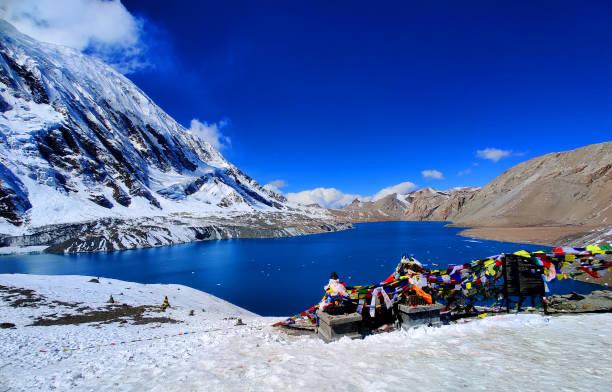
Jul 12, 2024
Best Time for Annapurna Circuit Trek
- Seasonal Overview of the Annapurna Circuit
- Trekking the Annapurna Circuit in Spring (March to May)
- Trekking the Annapurna Circuit in Monsoon (June to August)
- Trekking the Annapurna Circuit in Autumn (September to November)
- Trekking the Annapurna Circuit in Winter (December to February)
- Choosing the Best Season for Annapurna Circuit Trek
- Personal Preferences
- Physical Preparation and Prior Experience
- Things to Know Before Planning Your Annapurna Circuit Trek
- What is the Best Season to Avoid Crowds While Trekking the Annapurna Circuit?
- Can I Trek the Annapurna Circuit During Monsoon Season?
From the vibrant festivals of autumn to the serene solitude of winter, each season in the Annapurna region offers a unique experience. Discover how choosing the right time for the Annapurna Circuit trek can transform your adventure.
Embarking on the renowned Annapurna Circuit trek means immersing yourself in breathtaking landscapes and the grandeur of the Himalayas. While every season provides its own spectacular journey, selecting the ideal time can elevate your experience and make the trek more enjoyable.
In this guide, we delve into what each season on the Annapurna Circuit offers and help you find the perfect timing for your trekking adventure.
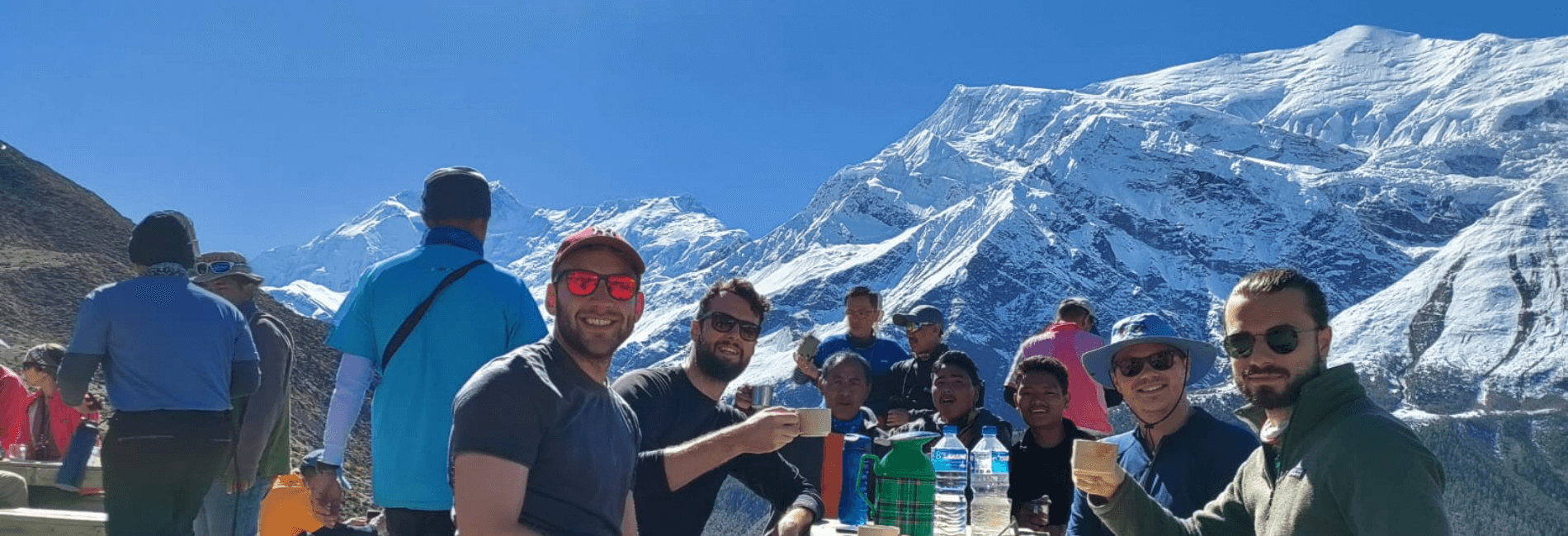
ANNAPURNA CIRCUIT TREK 7 DAYS
The 7 days Annapurna Circuit Trek is, for a good reason, one of the most popular treks in Nepal’s Annapurna Conservation Area where you will witness enormous snow-covered mountains, deep gorges &...
Seasonal Overview of the Annapurna Circuit
Nepal’s diverse geography results in a unique seasonal cycle, divided into four main seasons: Spring (March to May), Monsoon (June to August), Autumn (September to November), and Winter (December to February).
Each season brings its own set of landscapes, challenges, and rewards, making it a bit challenging to pinpoint the best time to visit. The Annapurna Circuit is accessible year-round, provided you have the necessary permits and documents.
However, the experience can vary significantly depending on the season. Here’s a detailed breakdown of what to expect during each season on the Annapurna Circuit trek:
- Spring (March to May): Enjoy vibrant flora and moderate temperatures, making it a prime time for trekking with excellent views and active wildlife.
- Monsoon (June to August): Expect heavy rains and slippery trails, but fewer crowds and lush, green landscapes. The northern sections offer a drier alternative.
- Autumn (September to November): This peak season offers clear skies, crisp air, and a chance to experience local festivals, though it can be crowded.
- Winter (December to February): Experience a serene, snow-covered landscape with fewer trekkers, but be prepared for cold temperatures and challenging conditions.
Understanding these seasonal variations will help you choose the best time for your Annapurna Circuit adventure.
Trekking the Annapurna Circuit in Spring (March to May)
Spring, spanning from March to May, is considered the peak trekking season in Nepal and offers a truly spectacular experience on the Annapurna Circuit.
During this season, the Annapurna region transforms into a vibrant landscape of colors. The lush valleys within the Annapurna Conservation Area are adorned with a stunning array of blooming rhododendrons in shades of pink, red, and white, along with wildflowers carpeting the hillsides. The melting snow from winter ushers in mild temperatures, ranging from 5 to 20 degrees Celsius, creating ideal trekking conditions.
With minimal chances of snow or rain, the skies are typically clear, providing unobstructed views of the majestic Annapurna and Dhaulagiri ranges. This clear visibility is one of the key attractions of trekking during this time.
Spring also offers excellent opportunities for wildlife enthusiasts, as the active wildlife becomes more visible following their winter dormancy. Birdwatchers and animal lovers will find this season particularly rewarding.
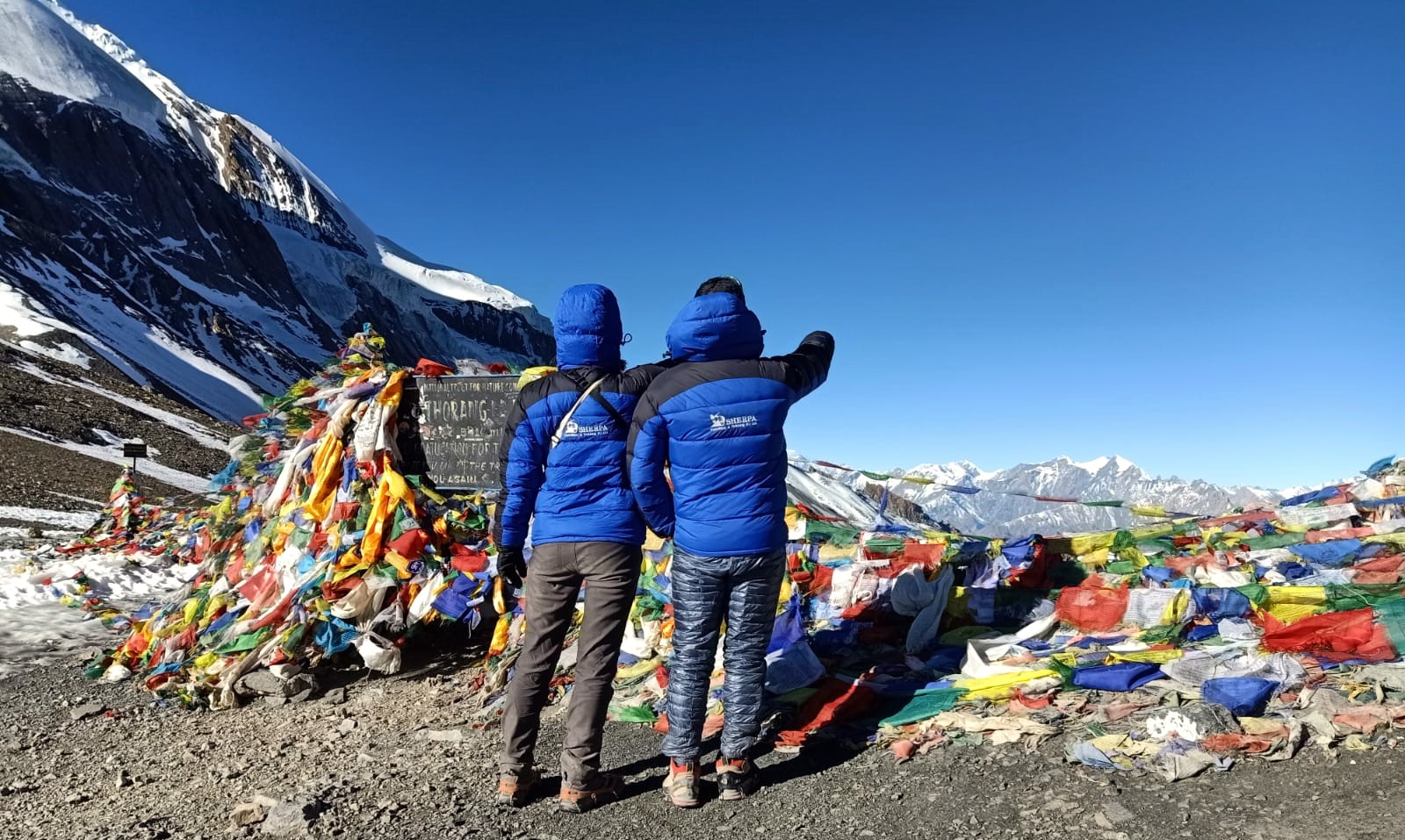
ANNAPURNA CIRCUIT WITH TILICHO LAKE TREK 9 DAYS
Short 9 Days Annapurna Circuit Trek with Tilicho Lake is one of the most impressive and challenging hikes in Nepal. It’s an incredibly popular trekking destination in Nepal and around the world given...
Additionally, spring coincides with several local festivals, including Holi and Nepali New Year, allowing trekkers to immerse themselves in local traditions and celebrations. However, the popularity of this season means that the trails can become quite crowded, which may impact the solitude of your trek.
If you choose to trek during spring, be prepared for the increased foot traffic by planning your accommodations and permits well in advance. Also, consider packing appropriate gear, including spikes and jackets, in case of unexpected snowfall. Despite the crowds, the combination of favorable weather, vibrant scenery, and cultural experiences makes spring a memorable time to undertake the Annapurna Circuit trek.
Trekking the Annapurna Circuit in Monsoon (June to August)
From June to August, the monsoon season envelops the Annapurna Circuit in a lush, green splendor, transforming the trail into a vibrant paradise. However, this season brings significant challenges, making it a more demanding time for trekkers.
Monsoon introduces heavy rainfall, resulting in a lush and verdant landscape, but also brings obstacles such as slippery trails, reduced visibility, and the risk of landslides. The trail can become infested with leeches, and the fog and rain limit visibility, even during the afternoons. Proper gear, including sturdy hiking boots and gaiters, becomes essential.
Despite these challenges, monsoon trekking has its unique advantages. The lack of crowds during this period offers a more solitary experience, allowing trekkers to enjoy the tranquility of the mountains without the typical hustle and bustle. The waterfalls and rivers, such as the Marshyangdi and Kali Gandaki, are at their most spectacular, and the flora is lush and vibrant, providing a rich biodiversity experience.
Temperatures during the monsoon season are generally moderate, ranging from –3°C at higher altitudes to 25°C at lower elevations, making the weather neither too hot nor too cold.

ANNAPURNA CIRCUIT WITH TILICHO LAKE TREK 15 DAYS
This 15-day trek takes you through the Annapurna Conservation Area and to the highest alpine pass in the world – Thorong La Pass (5,416m/17,769ft) and to Tilicho Lake. You will also trek through the d...
To tackle the monsoon season effectively, thorough preparation is crucial. Research the weather patterns carefully and prepare a comprehensive packing list that includes rain gear like waterproof bags, boots, jackets, and pants.
For those who are experienced and well-prepared, exploring the northern sections of the Annapurna Circuit, which are situated in the rain shadow of the Annapurna massif, can offer a rewarding adventure despite the seasonal challenges.
Trekking the Annapurna Circuit in Autumn (September to November)
From September to November, the Annapurna Circuit basks in the beauty of autumn, marking one of the peak trekking seasons in Nepal. This period is renowned for its comfortable conditions and the vibrant cultural atmosphere, making it an ideal time for a Himalayan adventure.
Autumn brings crystal-clear skies and breathtaking vistas, with temperatures ranging from 4°C to 20°C, creating perfect trekking conditions. The crisp air and reduced precipitation offer spectacular views of the Annapurna and Dhaulagiri mountain ranges. While temperatures can drop to around –5°C at night, the daytime weather is generally pleasant and conducive to trekking.
This season follows the monsoon rains, which clear the air and provide stunning, unobstructed views of the majestic peaks. Although there may be occasional snowfall towards the end of autumn, overall precipitation is minimal.
Autumn is also a culturally rich time to visit, as major Nepali festivals like Dashain and Tihar take place. Trekkers have the opportunity to immerse themselves in local traditions and celebrations, adding a unique dimension to their journey.
However, autumn is a popular season, so the Annapurna Circuit experiences a high volume of trekkers. This influx can lead to crowded trails, so it’s advisable to book accommodations, guides, and porters well in advance to ensure a smooth and enjoyable trekking experience.
Trekking the Annapurna Circuit in Winter (December to February)
Embarking on the Annapurna Circuit from December to February offers a unique and challenging adventure as the region transforms into a winter wonderland. This season brings a serene, snow-covered landscape, making for a visually stunning yet demanding trekking experience.
Winter on the Annapurna Circuit means trekking through pristine snowy trails with minimal crowds, allowing for a tranquil and solitary journey. The untouched snow and clear skies offer breathtaking views of the Himalayan peaks, with every mountain shining brightly against the crisp, clear air.

ANNAPURNA CIRCUIT BUDGET TREK
BIG ON FEATURES – FOR THOSE SHORT OF TIME!Annapurna Circuit Trek is considered one of the best treks in Nepal’s Annapurna Conservation Area with its massive ranges, deep gorges & high passes.This...
However, winter conditions pose significant challenges. Temperatures can drop to as low as –10°C at night and range from 5 to 10°C during the day. Snowfall is frequent, which adds to the beauty but also makes trails slippery and potentially hazardous. There is a risk of trail blockages, including major mountain passes like Thorong La, which may become impassable.
Due to the cold and snow, it is essential to be well-prepared. Carrying the right gear is crucial—spikes, crampons, and ice axes will help navigate the icy trails, while insulated clothing, fleece jackets, and zero-degree sleeping bags are necessary to handle the extreme temperatures.
For seasoned trekkers seeking a quieter experience amidst stunning winter landscapes, the Annapurna Circuit in winter can be a rewarding adventure, provided you are prepared for the challenges it presents.
Choosing the Best Season for Annapurna Circuit Trek
Selecting the ideal time for your Annapurna Circuit trek depends largely on your personal preferences and what you hope to gain from the experience. Each season offers a unique set of conditions and highlights, so the best time to trek can vary from person to person.
Here are some key factors to consider when deciding the best time for your Annapurna Circuit adventure:
- Personal Preferences:
- Spring (March to May): Ideal if you enjoy vibrant landscapes with blooming rhododendrons and wildflowers. Spring offers comfortable temperatures and clear skies but is also the peak trekking season, which means more crowds.
- Autumn (September to November): Perfect for those seeking clear skies, crisp air, and cultural experiences during local festivals. It is another peak season, so you’ll need to plan ahead to avoid the crowds.
- Winter (December to February): Best for those looking for solitude and breathtaking snowy landscapes. Winter is less crowded but requires preparation for extreme cold and potential trail blockages.
- Monsoon (June to August): Offers a lush, green landscape with fewer trekkers, but comes with challenges such as heavy rain, slippery trails, and leeches. It's best suited for experienced trekkers who are prepared for the wet conditions.
- Physical Preparation and Experience:
- Spring and Autumn: These seasons provide more stable weather conditions and are suitable for trekkers of all levels, including beginners.
- Winter: Requires high physical fitness and prior trekking experience due to extreme cold and snowy conditions.
- Monsoon: Demands experience and careful planning to handle the slippery and challenging trails.
- Crowds and Solitude:
- Spring and Autumn: Expect larger crowds during these peak seasons, which might affect your experience if you prefer solitude.
- Winter: Offers a more solitary experience with fewer trekkers, perfect for those seeking tranquility.
- Monsoon: While quieter, the challenging conditions may outweigh the benefits of fewer people on the trail.
Ultimately, the best season for trekking the Annapurna Circuit depends on your personal goals, comfort with varying weather conditions, and the type of experience you’re seeking.

15 DAYS ANNAPURNA CIRCUIT TREK
A WILD ADVENTURE AMONG SOARING PEAKS - THE DEEPEST VALLEY ON EARTH & EXPOSURE TO UNIQUE CULTURES.THIS TREK HAS IT ALL!The 15 Days Annapurna Circuit Trek is time well spent and will leave you with...
Personal Preferences
Choosing the best season for the Annapurna Circuit trek largely depends on what you want to experience from your adventure:
- Spring (March to May): Ideal for those who wish to immerse themselves in the vibrant scenery of blooming rhododendrons and wildflowers. Spring offers comfortable trekking conditions with moderate temperatures and clear views of the mountains. This is also the peak trekking season, so you can expect a lively atmosphere with fellow trekkers.
- Autumn (September to November): Perfect for those seeking a culturally rich experience. Autumn coincides with major Nepali festivals like Dashain and Tihar, providing an opportunity to engage in local traditions. The weather is crisp and clear, offering excellent visibility and a refreshing trekking experience. However, be prepared for increased foot traffic on the trail.
- Winter (December to February): Best suited for those who value solitude and the serene beauty of a snow-covered landscape. Trekking during winter means fewer crowds and a tranquil environment, but it also involves extreme cold and challenging conditions. Proper preparation and experience are essential to navigate the snowy trails safely.
- Monsoon (June to August): Although not generally recommended due to heavy rainfall, slippery trails, and leeches, the monsoon season offers a unique experience for seasoned trekkers. If you are keen on a solitary adventure and are well-prepared for the challenges, this season provides an opportunity to enjoy the lush, green landscapes and vibrant biodiversity away from the usual trekking crowds.
Physical Preparation and Prior Experience
While the Annapurna Circuit trek can be an accessible adventure for beginners, some seasons present more demanding conditions that require prior experience and robust preparation:
- Winter (December to February): Trekking in winter necessitates a high level of physical fitness and mountaineering skills. The snow-covered trails require experience with ice navigation and handling extreme cold. If you’re considering a winter trek, you must be prepared for slippery paths, freezing temperatures, and potential trail blockages.
- Monsoon (June to August): The monsoon season introduces challenges such as slippery trails, low visibility, and heavy rainfall. It demands technical strength and experience to manage the risk of landslides and navigate leech-infested paths. This season is best suited for those with prior trekking experience and the ability to handle adverse weather conditions.
- Spring (March to May) and Autumn (September to November): For beginners with average physical fitness, spring and autumn are ideal. These seasons offer favorable weather conditions with moderate temperatures and clear skies, making the trek more manageable. Spring provides a burst of floral beauty, while autumn offers crisp air and vibrant cultural experiences. Both seasons present less technical difficulty compared to winter and monsoon, making them suitable for less experienced trekkers.

ANNAPURNA ROUND TREK
WORLD-CLASS TREK THROUGH THE (7,629 sq km) Annapurna Conservation Area – the largest in Nepal.The Annapurna Circuit has often been voted as the best long-distance trek in the world!This is a comprehen...
Things to Know Before Planning Your Annapurna Circuit Trek
Once you’ve determined the best season for your Annapurna Circuit trek, several key considerations can help ensure a successful and comfortable journey:
Permits: You need to obtain specific permits to trek the Annapurna Circuit. These include:
- TIMS (Trekkers' Information Management System) Card
- ACAP (Annapurna Conservation Area Permit)
Ensure these permits are secured before starting your trek as they are mandatory for entry into the Annapurna Conservation Area.
- Packing List: Prepare a detailed packing list that includes:
- Season-appropriate Clothing: Depending on the season, this may include layers, waterproof gear, and warm clothing.
- First Aid Kit: Essentials for minor injuries and health issues.
- Sleeping Gear: Sleeping bag rated for the temperatures you’ll encounter.
- Other Essentials: Trekking poles, headlamp, and personal items.
- Luggage Weight: Be mindful of weight limits for porters. Carry only what you need to respect ethical porter practices and ensure that your luggage is manageable.
- Local Customs: Familiarize yourself with local customs and traditions. Learning simple phrases like "Namaste" can enhance your cultural experience and interactions with local communities.
- Guide: Solo trekking is not permitted in Nepal. Hiring a guide ensures safety and enriches your experience with local knowledge. Guides are familiar with the region and can offer valuable insights and support.
- Local Trekking Agency: Partnering with a reputable local trekking agency, such as Ace the Himalaya, can streamline your trek by handling logistics like accommodation, guides, permits, and porters.
- Physical Preparation: Begin training well in advance to build the physical fitness needed for the trek. Adequate preparation will help you handle the trek’s challenges more effectively.
By addressing these aspects, you can ensure a well-prepared and enjoyable trek through the Annapurna Circuit.
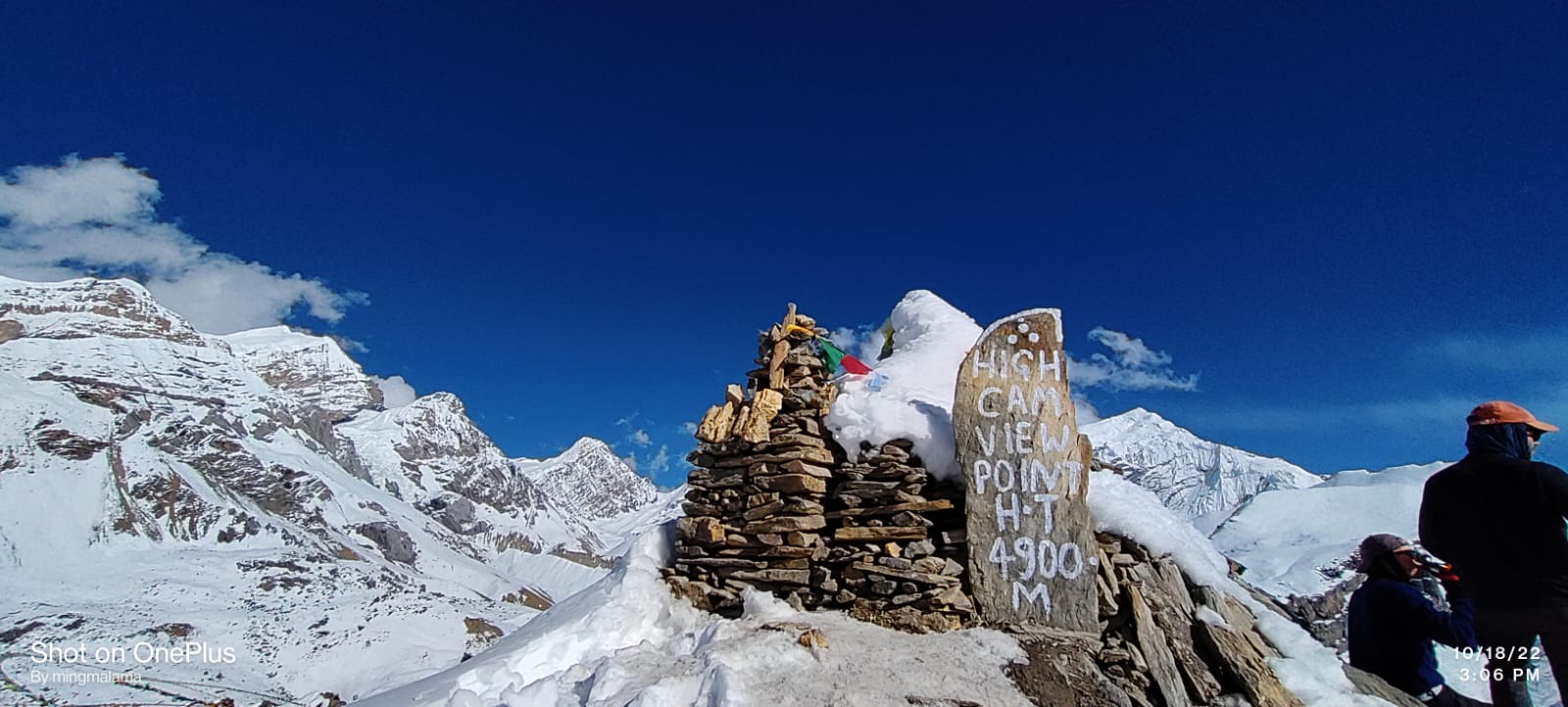
ANNAPURNA CIRCUIT TREK 13 DAYS
This is an ideal trekking destination for nature lovers and for those who enjoy the wilderness! This trek takes you through the Annapurna Conservation Area and to the highest pass and the de...
What is the Best Season to Avoid Crowds While Trekking the Annapurna Circuit?
To avoid crowds on the Annapurna Circuit, winter (December to February) is the optimal season. During these months, colder temperatures and heavy snowfall lead to fewer trekkers on the trail. While wildlife activity decreases and there's a risk of trail blockages, the serene, snow-covered landscapes and clear skies offer a breathtaking experience.
For a truly solitary adventure, be prepared for freezing temperatures and shorter daylight hours. Despite the challenges, winter provides a unique and tranquil Himalayan experience, making it ideal for those seeking solitude.
Can I Trek the Annapurna Circuit During Monsoon Season?
Yes, the Annapurna Circuit trek is open year-round, including during the monsoon season (June to August). However, trekking during this period presents several challenges. Heavy rainfall leads to slippery trails, increased risk of landslides, and frequent leech infestations. The weather also reduces visibility and can make the trek uncomfortable.
Despite the potential for solitude and fewer crowds, the difficulties often outweigh the benefits. If you're set on trekking during the monsoon, consider focusing on the northern sections of the circuit, such as Mustang, which are in the rain shadow and experience less rainfall.
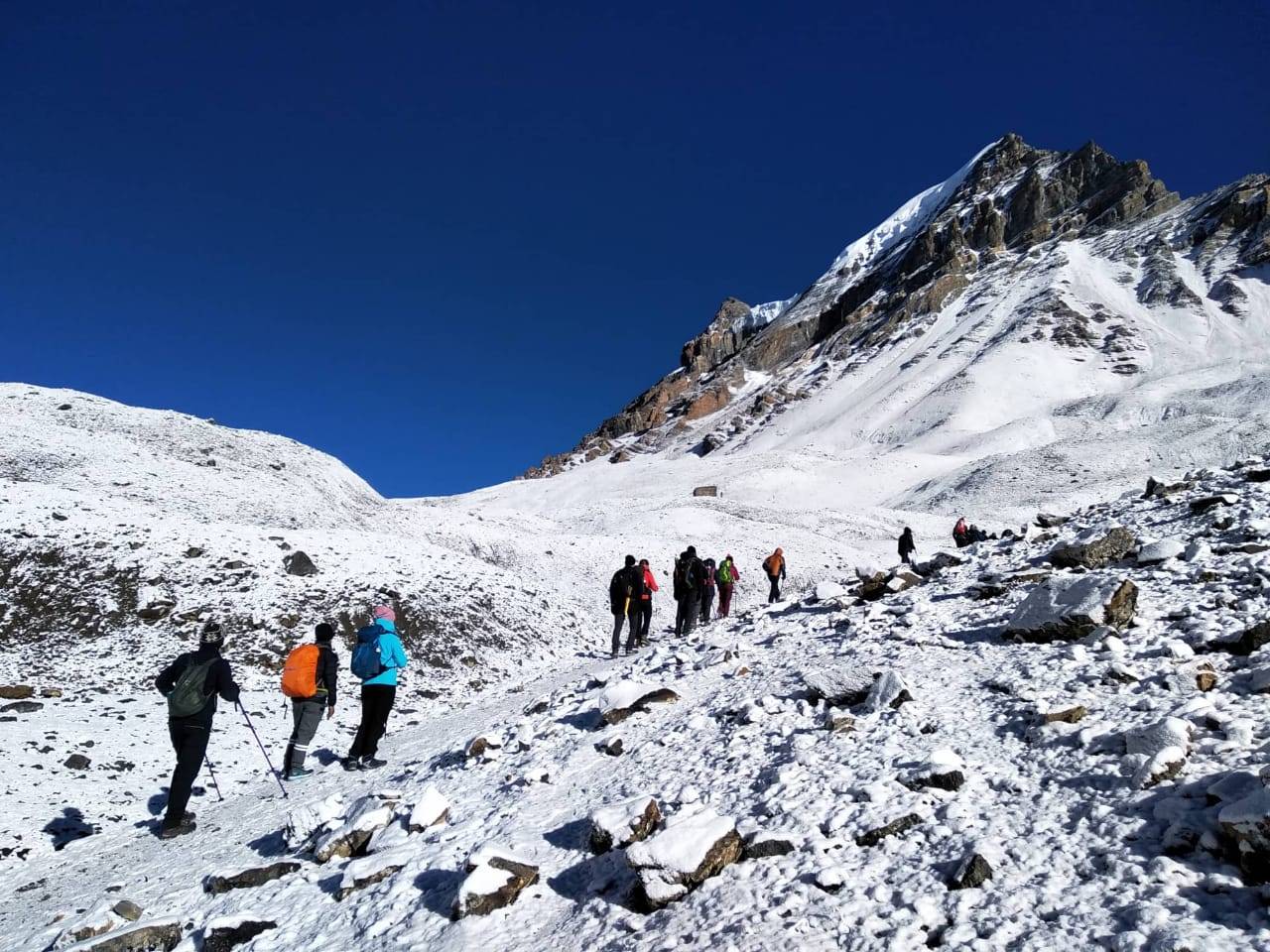
ANNAPURNA CIRCUIT TREK
A LIFE-CHANGING EXPERIENCE – incredible beauty!Circumnavigate the Annapurnas – with one peak at 8091m & 28 peaks over 6000m surrounded by the Kali Gandaki Gorge, Marshyangdi River & Pokhara in...
Any Questions? Let Us Know.
Recent Posts
17th June, 2025


















